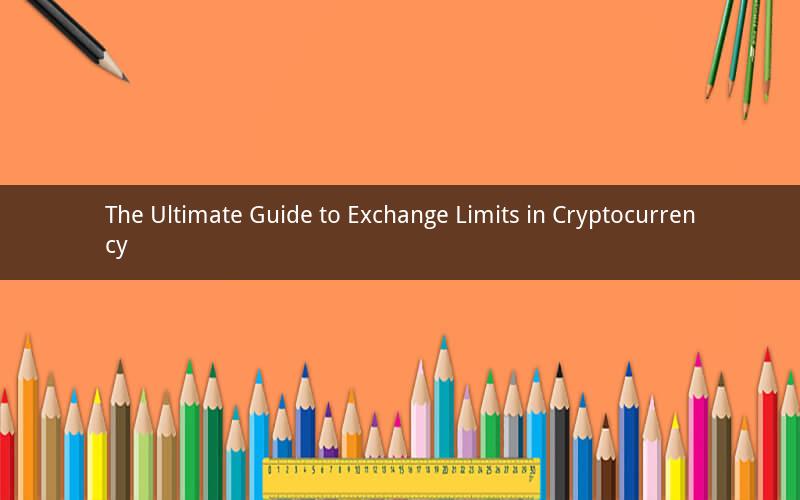
Introduction:
Cryptocurrency has revolutionized the financial world, offering individuals the ability to exchange digital assets seamlessly. However, many users are curious about the maximum number of cryptocurrencies they can exchange at a time. In this article, we will explore the factors that determine these limits and provide you with valuable insights into maximizing your cryptocurrency exchange experience.
1. Understanding Exchange Limits
Exchange limits refer to the maximum amount of cryptocurrency or fiat currency that a user can exchange within a specific timeframe. These limits are set by various factors, including the exchange's policies, regulatory requirements, and the overall liquidity of the market.
1.1 Exchange Policies
Each cryptocurrency exchange has its own set of policies regarding exchange limits. Some platforms may impose strict limits on new users to prevent fraudulent activities, while others may gradually increase the limits as users complete verification processes. It is essential to review the exchange's policies before initiating any transactions.
1.2 Regulatory Requirements
Regulatory authorities impose certain requirements on cryptocurrency exchanges to ensure compliance with anti-money laundering (AML) and know-your-customer (KYC) regulations. These requirements often dictate the exchange limits that platforms can offer to their users.
1.3 Market Liquidity
The liquidity of the market plays a crucial role in determining exchange limits. If an exchange lacks sufficient liquidity in a particular cryptocurrency, it may impose lower limits to avoid potential market manipulation or excessive slippage.
2. Types of Exchange Limits
There are primarily two types of exchange limits: account limits and transaction limits.
2.1 Account Limits
Account limits refer to the overall maximum amount of cryptocurrency or fiat currency that a user can exchange within a specific period, such as a day, week, or month. These limits are determined by the exchange's policies and regulatory requirements.
2.2 Transaction Limits
Transaction limits, on the other hand, refer to the maximum amount of cryptocurrency or fiat currency that can be exchanged in a single transaction. These limits are often set lower than account limits to prevent large-scale transactions that could potentially disrupt the market.
3. How to Increase Exchange Limits
If you find that your exchange limits are too restrictive, there are several ways to increase them:
3.1 Complete Verification Process
Many exchanges require users to complete the verification process, which typically involves providing identification documents and proof of address. By completing this process, you may become eligible for higher exchange limits.
3.2 Increase Your Trading Volume
Exchanges often reward active traders by increasing their limits. By increasing your trading volume and demonstrating responsible behavior, you may be eligible for higher limits.
3.3 Contact Customer Support
If you have a valid reason for requiring higher exchange limits, you can contact the exchange's customer support team. They may review your request and consider increasing your limits based on your trading history and risk profile.
4. Risks of Exceeding Exchange Limits
While it may be tempting to exceed exchange limits, doing so can pose several risks:
4.1 Increased Risk of Market Manipulation
Exceeding exchange limits can lead to potential market manipulation, as large transactions may cause significant price movements. This can affect the overall market stability and may result in penalties from the exchange or regulatory authorities.
4.2 Higher Slippage
Large transactions may experience higher slippage, which refers to the difference between the expected price of a trade and the price at which the trade is executed. This can result in unfavorable trade outcomes and potential losses.
4.3 Legal and Regulatory Consequences
Exceeding exchange limits may violate the exchange's policies and regulatory requirements, leading to legal and regulatory consequences. It is crucial to adhere to the established limits to avoid any legal issues.
5. Related Questions and Answers
Q1: How do I check my exchange limits on a cryptocurrency platform?
A1: To check your exchange limits, log in to your account and navigate to the trading or account section. Most exchanges provide a clear overview of your account limits, including both account limits and transaction limits.
Q2: Can I increase my exchange limits immediately after completing the verification process?
A2: In some cases, you may be eligible for higher limits immediately after completing the verification process. However, it is advisable to check the exchange's policies and wait for any required cooling-off periods before expecting an immediate increase in limits.
Q3: Can I exceed my exchange limits by using multiple accounts?
A3: No, using multiple accounts to exceed your exchange limits is considered fraudulent and can result in the suspension of your accounts. It is essential to adhere to the established limits and follow the exchange's policies.
Q4: How long does it take to increase my exchange limits after contacting customer support?
A4: The time it takes to increase your exchange limits after contacting customer support can vary depending on the exchange's policies and the complexity of your request. Some exchanges may respond within a few hours, while others may take several days.
Q5: Are there any risks associated with increasing my exchange limits?
A5: Yes, there are risks associated with increasing your exchange limits. These include potential market manipulation, higher slippage, and legal and regulatory consequences. It is crucial to consider these risks and make informed decisions when seeking to increase your exchange limits.
Conclusion:
Understanding the maximum number of cryptocurrencies you can exchange at a time is essential for maximizing your cryptocurrency trading experience. By familiarizing yourself with exchange limits, adhering to the exchange's policies, and taking necessary precautions, you can ensure a smooth and secure cryptocurrency exchange process. Remember to always prioritize the risks and seek guidance from the exchange's customer support team if needed.